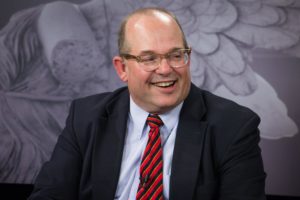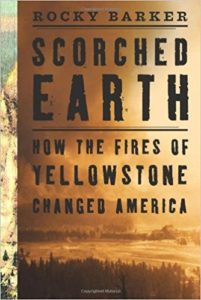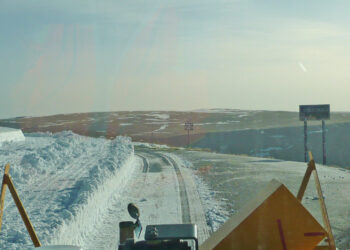
Thirty years ago, following the spring warmup, a storm pattern rolled into the Greater Yellowstone Ecosystem, leading many to believe the rest of summer would be “normal.”
Some 18 lightning-caused fires started in Yellowstone National Park in June, all allowed to burn. Eleven went out naturally, the rest creeping at a low-grade crawl, the expectation being that they would stay tamped down by July monsoonal moisture.
The rains never came. Days of scorching temperatures, little precipitation and strong winds yielded a fire season for the record books. A third of Yellowstone was blackened by flame.
For me, it was a defining time to be an environmental reporter in the region. No day was more memorable than Sept. 7, 1988, when the North Fork Fire, driven by hurricane-force winds burned over the top of us and nearly claimed the Old Faithful Inn.
The 1988 Yellowstone fires were called a modern turning point in our understanding of forest fire behavior.

Barker wrote a book, “Scorched Earth,” about the 1988 blazes that was turned into a movie.
“The Yellowstone fires of 1988 did teach firefighters humility and made many fire bosses overall less apt to throw folks in front of big fires,” he said. “But in many ways it set back the effort to restore fire to Western forests. The negative public reaction and the political fallout made managers less willing to take even small risks to allow fires to burn. They wanted fire only under the most careful conditions, which of course, is not natural in the historic sense.”
About his most vivid moment, he said, “Well, you were there. You watched me run from the fire at Old Faithful, Todd! I still get nightmares about that moment. I think when you run on adrenaline for a long time it triggers things in your head.”
In his 2007 book, Barker recounts how fire suppression in Yellowstone started with an order from Civil War Gen. Phil Sheridan, who commanded park management in the early days—and was notorious for his despicable policies toward indigenous people.
“What I learned and wanted to show was that Sheridan, one of history’s least likable heroes, played the critical role in placing land conservation in the hands of government and making government control the centerpiece of conservation and eventually environmentalism,” Barker said.
“Sheridan wasn’t sophisticated enough to consider fire’s role but he intuitively recognized that to protect the elk, bison and other big game he loved in Yellowstone, he had to protect all of the habitat,” he added. “His ‘Greater Yellowstone’ idea wasn’t big science but it was a big idea that was rediscovered by the Leopolds, the Craigheads and others.”
We reflected on how “climate change” was then only beginning to establish a pattern and how today some politicians still claim logging forests will save them.
“The high elevation forests like Yellowstone are going to burn big no matter what we do,” Barker said. “Beetles, while making forests more volatile briefly, actually thin these forests and reduce their ability to carry big fire but when conditions are right—and since the 1980s conditions have been right regularly, we’re going to have big fire.”
He believes there’s a disconnect between the public’s desire to have healthy landscapes and individuals moving into forests. Would homeowners think different if the government didn’t bail them out with fire protection?
“Absolutely,” Barker said. “The real tough solution would be to zone forests where firefighters won’t go to fight fires because of the danger, cost and lack of resources.”
 Notable about Barker’s book is how it connects dots of people—including journalists—bonded by fire. “I reveled in the stories of Sheridan and Jay Cooke, Nathaniel Pitt Langford and Moses Harris, John Muir and Gifford Pinchot and Aldo Leopold whose ambitions and ideologies converged at Yellowstone,” he said.
Notable about Barker’s book is how it connects dots of people—including journalists—bonded by fire. “I reveled in the stories of Sheridan and Jay Cooke, Nathaniel Pitt Langford and Moses Harris, John Muir and Gifford Pinchot and Aldo Leopold whose ambitions and ideologies converged at Yellowstone,” he said.
“I thought I knew these men until I got the chance to research this book. FDR’s last act before his polio came on was to fight a forest fire. Aldo Leopold died in a forest fire. Don Despain, [Yellowstone’s renowned fire ecologist], played with matches as a kid. Most of all I was struck by the missed opportunities of understanding the arid West first posited by John Wesley Powell.”
The fires of 1988, Barker said, represented a progression of thinking. Muir spoke at Thoreau’s funeral and knew Ralph Waldo Emerson. “He taught both Theodore Roosevelt and Gifford Pinchot. Pinchot taught Leopold. Leopold taught his son Starker. Starker taught Yellowstone Superintendent Bob Barbee who presided over the park when the ‘88 fires blew up. The connections are so powerful.”
Where do we go from here? Is society better equipped today to co-exist with fire?
“We have no choice but to live with fire,” he said. “With global warming likely tied to our own behavior we have joined fire and the other natural forces—floods, landslides, volcanoes, hurricanes, even erosion—in generating the power to reshape the world. What remains unresolved is not whether we can control nature but whether we can control ourselves.”
Todd Wilkinson is the founder of Mountain Journal (mountainjournal.org) where you can read his latest story about climate change. He is author of “Grizzlies of Pilgrim Creek” about famous Greater Yellowstone grizzly bear 399 featuring 150 photographs by Tom Mangelsen, available only at mangelsen.com/grizzly. His feature on the delisting of Greater Yellowstone grizzlies appears in the winter 2018 issue of Mountain Outlaw and is now on newsstands.












